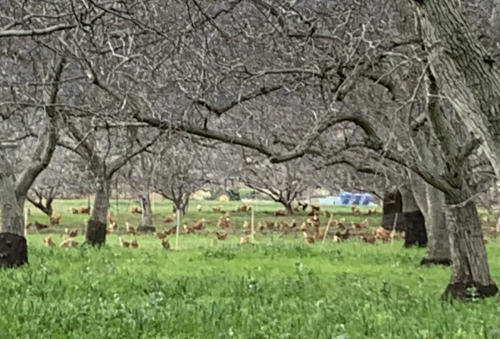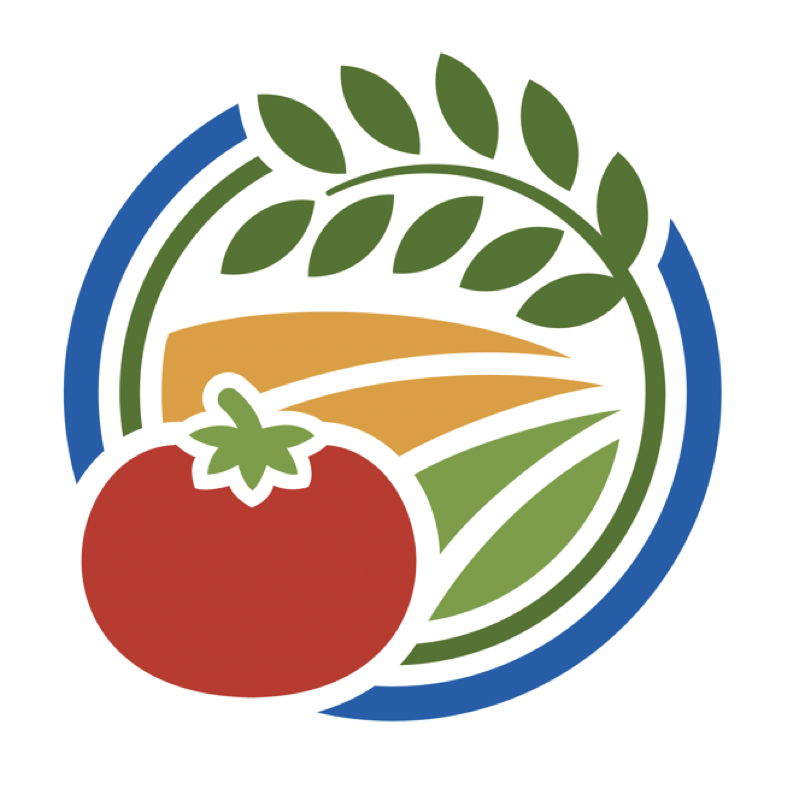
Farm Information
County: Yolo
Location: Capay Valley. Cache Creek Watershed
Slope: Flat
Irrigation system: Micro-sprinklers and hand line.
Soil type: Clay loam
Soil detail: Clay loam
Special farming challenges: n/a
- Cropping Systems Information
- Crop: walnuts
Acres of orchard or vineyard: 70Other crops: Diversified vegetables, flowers, grain crops, seed crops and pastured poultry and livestock
Acres of other crops: 500acres mix in winter/spring.150 acres of vegetables in rotation, year round. Another 150 acres summer/fall. 1500 chickens, mostly layers, 300 head of sheep, integrated into fields and orchards, and dedicated pasture, hay for livestock, also have grain crops, corn, and wheat.
Organic management: Yes
Certifications: CCOF organic, Real Organic Project
Certifications notes: n/a
Where using cover crops: Almost every orchard has permanent cover. - Grower Experience, Farm Priorities, and Cover Cropping Goals
- When started farming (yr): 1984
Farm priorities:
Maximize the total harvest of the system in different ways. Not just measured in pounds of nuts, but thinks about capturing sun light, root growth, benefical pest attraction as part of the the harvest. “We try to have green under the trees all the time, we try to harvest as much sunlight as possible.”
Years growing orchard or vineyard crop: 36 years
Years growing cover crops: 36 years
Initial transition to cover cropping: Their original idea was to cover crop orchard blocks amongst their diversified vegetables as biological resevoirs for beneficial insects. The flowering cover crops would provide habitat and the insects would migrate to the fields. They are unsure how well that has actually worked--flowering plants may need to be closer or within vegetables--but still many other ecosystem services. Because of original equipment, early on they would disc, overseed and then harrow.
Goals and benefits: Soil improvement, prevent frost damage
Benefits description: Good to prevent frost damage, good mulch and increase rain infiltration
Change in goals over time: Yes, while they aren't sure of the extent of pest benefits in neigboring vegetables, there is clear evidence that species diversity improves soil diversity, and there is a suite of soil benefits associated with that.
Reasons: In the orchards, the primary focus of the cover crops is now to try to get something growing in the fall as ground protection for the soil and to hold the fallen leaves and provide compost and food sources for the soil macrolife. - Cover Crop Details, Planting and Management Methods
-
Block described here: Walnuts
Current cover crops: Legumes, grasses, brassicas, insectary mix
Species and mixes: They use a wide variety of cover crops, but usually start with a general purpose mix they grow and thresh themselves of vetch, barley, oats, peas, etc. From there, will often source the TS&L Organic Orchard mix (3 to 4 clovers, perennial rye grass, trefoil). Also use tillage radish, phacelia, and sunflowers, bell beans, buckwheat, mustards.
Planting method: Drill seed
Planting date (2020): They use a wide variety of cover crops, but usually start with a general purpose mix they grow and thresh themselves of vetch, barley, oats, peas, etc. From there, will often source the TS&L Organic Orchard mix (3 to 4 clovers, perennial rye grass, trefoil). Also use tillage radish, phacelia, and sunflowers, bell beans, buckwheat, mustards.
Was that optimal? The optimal time to plant is right after the cash crop harvest, because he has sprinklers watering the cover crops seeds. Any cover established post-harvest will capture leaf litter for keeping soil covered and leaves from leaving the orchard.
Pre-plant soil prep: None
Planting equipment: No-till drill.
Seeding rate: about 60 lbs/acre including vetch, clovers, buckwheat, oats, mustards, some bell beans, sunflowers, rye, and peas
Seeding depth: Pressed into the surface.
Did it germinate well? Yes
Additional management and advice: In the spring when the walnuts begin to push and bloom, we’ll look at the weather. If cover crop is tall and rank, we’ll mow it high 6-8 inches, to manage frost damage. If you mow it too tight, you’ll kill some of the species. Goal is to get through bloom period without too high a cover – and get some regrowth on it after mowing. Also think of rolling down the cover during bloom period. It provides a good mulch, and spring rain will infiltrate much better. Goal is to optimize surface that can absorb sunlight, while also covering ground. We do water the middles – hanging micro-sprinkler (hanging droppers) so we can cross mow through the tree rows. Have cover crop in tree rows as well as middles. Use an articulating mower that can weave in and out of trees. Hoses are 5 ft up through trees. Orchard floor is not bermed up in the tree row so we can cross mow. - Cover Crop Termination Methods and Biomass Management
-
Termination method: Mow, graze
Termination equipment and process: Sheep grazing when ground is dry enough. Rotary mower to control height. Sheep removed by June 1, 120 days before harvest.
Termination date: Mow tight when closer to harvest, mow 6 times total over the year. Do not mow too tight in order to cover regrowth. Use rotary mower first in spring time, because it allows them to clip the tops a little higher. Then use flail mower for subsequent mowing.
Was it optimal? If you have a rain coming, and you have to spray trees, you have to think ahead as to how you manage the height and firmness of the orchard floor.
Biomass management: Leave in place to capture as much leaf litter as possible under trees. - Cover Cropping Challenges and Strategies to Address Them
- Challenges: Termination difficulties, Risk of frost, Orchard floor residue at harvest
Challenges description: The use of roller/crimper in orchards. Bell beans, mustard and winter peas die when rolled down, but vetch and grasses will often regrow after being knocked down.
Strategies to address challenges: Roll it a couple of times if trying to terminate grasses and vetches. For frost risk, the traditional belief is that the lower down you mow during the bloom period, the better you are in terms of frost protection. But he thinks you don’t gain that much by mowing it really tight – you gain more by having leaf surfaces continuing to push sugars into the soil. Manage for optimal coverage on the floor and reduce evaporation. Harvest residue: Cover crop residue, if chopped up fine enough, will absolutely break down by harvest time, if you don’t water. Chop once or twice with a flail mower. Then it is not a factor at all later on.
Was the cover crop worth it? "Yes. We’re trying to grow nice crops and grow soil at the same time. We’re trying to get more out of the whole system. The trade-off is more fuel, and more operator time – it’s more expensive. But if we want to reduce evaporation, and decrease water applied, it’s all part of the system. In order to have better water holding capacity, you need to add organic matter to begin to boost that. So when you do get rain, you can capture it."
Least successful past cover crops: n/a
